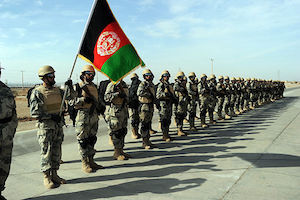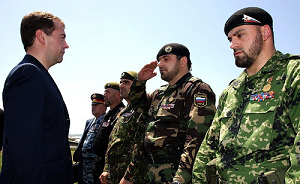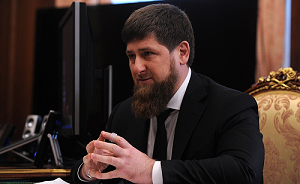Are We Seeing the Beginning of ISIS-Taliban Collaboration in Afghanistan?
By Sudha Ramachandran
November 13, 2017, the CACI Analyst
The attack at Mirza Olang village in Sayad district of Afghanistan’s Sar-e Pul Province on August 5 is reported to have been a joint operation by the Taliban and the Islamic State of Khorasan Province (ISKP), the local branch of the terrorist organization known as the Islamic State of Iraq and Syria (ISIS) (Khorasan is an old name for the region that includes parts of present-day Afghanistan, Pakistan, Iran and Central Asia). If the Taliban and ISKP did indeed join forces to carry out the attack, this is bad news for the Afghan government and people. However, given the huge differences and tense relations between the two armed groups, cooperation, if any, is likely to be local, tactical and short-lived.

Ingush Police to support Chechen Units in Syria
By Huseyn Aliyev
April 26, 2017, the CACI Analyst
A 300-strong battalion of Ingush military police, assembled from among Ingush Special Forces, was dispatched to Syria in February as announced by the head of the Ingush Republic Yunus-bek Yevkurov. According to the Russian Ministry of Defence, Ingush soldiers will replace Chechen military police sent to support pro-Assad forces in and around Aleppo in December 2016. However, in a recent statement, Chechen security officials confirmed that the Chechen units would most likely remain in Aleppo until August 2017. As ceasefire violations between pro-Assad forces and the Syrian opposition become more frequent, reinforcements from Ingushetia may indicate Russia’s intentions to increase its ground troops in Syria.

Attacks in Chechnya Suggest Opposition to Kadyrov is Far from Eradicated
By Emil Souleimanov
March 24, 2017, the CACI Analyst
At the turn of 2016 and 2017, events took place in parts of Chechnya that again challenged the triumphant statements of local pro-Moscow and federal authorities that the jihadist-inspired insurgency in this North Caucasian republic was eradicated. Aside from illustrating the latent character of armed conflict in the region in general and in Chechnya in particular, the recent upsurge of violence in Chechnya contains particularities that may have far-reaching consequences. Sporadic attacks against the Kadyrov regime will likely recur in the years to come and intensify should the regime’s grip on power weaken. 
Islamic State-inspired attacks continue in Chechnya
By Huseyn Aliyev
February 7, 2017, the CACI Analyst
On December 17, 2016, a shootout in central Grozny between members of the terrorist organization known as the Islamic State in Iraq and Syria (ISIS) and local security forces claimed the lives of three militants and one police officer. On December 18, a counter-terrorist operation (CTO) launched in the aftermath resulted in the death of four more insurgents, whereas four remaining members of a militant cell were arrested. Three police officers were killed and one injured.
While the confrontation between militants and police in Grozny was only the fourth conflict-related incident in the republic during 2016, it demonstrates that ISIS still has the capacity to target Chechen security forces.
New signs of Chinese military interest in Central Asia
By Stephen Blank
January 16th, 2017, The CACI Analyst
Recent evidence shows a gradual increase in Chinese military activity in Central Asia, particularly with Tajikistan, Afghanistan, and Pakistan, although China has for years denied any military interest in the region. In October, PLA and Tajik forces jointly participated in counterterrorism exercises in Tajikistan near the border with Afghanistan, following earlier activity in 2016. Whereas Tajikistan was then silent, this time it publicized the exercises, which aroused a visible anxiety in the Russian media although the Russian government has hitherto been unwilling to comment on this issue. China’s initiative could imply a major new development in Chinese policy and in Central Asia’s overall security, with lasting implications for the region.






